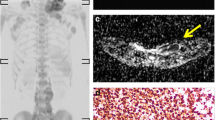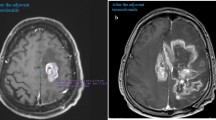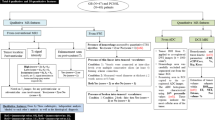Abstract
Purpose
Previously, some reports mentioned that magnetic resonance imaging (MRI) can predict histopathological features in primary CNS lymphoma (PCNSL). The reported data analyzed diffusion-weighted imaging findings. The aim of this study was to investigate possible associations between histopathological findings, such as tumor cellularity, nucleic areas and proliferation index Ki-67, and signal intensity on T1-weighted and T2-weighted images in PCNSL.
Procedures
For this study, 18 patients with PCNSL were retrospectively investigated by histogram analysis on precontrast and postcontrast T1-weighted and fluid-attenuated inversion recovery (FLAIR) images. For every patient, histopathology parameters, nucleic count, total nucleic area, and average nucleic area, as well as Ki-67 index, were estimated.
Results
Correlation analysis identified several statistically significant associations. Skewness derived from precontrast T1-weighted images correlated with Ki-67 index (p = − 0.55, P = 0.028). Furthermore, entropy derived from precontrast T1-weighted images correlated with average nucleic area (p = 0.53, P = 0.04). Several parameters from postcontrast T1-weighted images correlated with nucleic count: maximum signal intensity (p = 0.59, P = 0.017), P75 (p = 0.56, P = 0.02), and P90 (p = 0.52, P = 0.04) as well as SD (p = 0.58, P = 0.02). Maximum signal intensity derived from FLAIR sequence correlated with nucleic count (p = 0.50, P = 0.03).
Conclusion
Histogram-derived parameters of conventional MRI sequences can reflect different histopathological features in PSNCL.


Similar content being viewed by others
Abbreviations
- ADC:
-
Apparent diffusion coefficient
- DCE:
-
Dynamic contrast-enhanced MRI
- DWI:
-
Diffusion-weighted imaging
- PCNSL:
-
Primary CNS lymphoma
- ROI:
-
Region of interest
- SI:
-
Signal intensity
References
Citterio G, Reni M, Gatta G et al (2017) Primary central nervous system lymphoma. Crit Rev Oncol Hematol 113:97–110
Haldorsen IS, Espeland A, Larsson EM (2011) Central nervous system lymphoma: characteristic findings on traditional and advanced imaging. AJNR Am J Neuroradiol 32:984–992
Kickingereder P, Wiestler B, Sahm F et al (2014) Primary central nervous system lymphoma and atypical glioblastoma: multiparametric differentiation by using diffusion-, perfusion-, and susceptibility-weighted MR imaging. Radiology 272:843–850
Barajas RF, Rubenstein JL, Chang JS et al (2010) Diffusion-weighted MR imaging derived apparent diffusion coefficient is predictive of clinical outcome in primary central nervous system lymphoma. AJNR Am J Neuroradiol 31:60–66
Schob S, Meyer J, Gawlitza M et al (2016) Diffusion-weighted MRI reflects proliferative activity in primary CNS lymphoma. PLoS One 11:e0161386
Huang WY, Wen JB, Wu G et al (2016) Diffusion-weighted imaging for predicting and monitoring primary central nervous system lymphoma treatment response. AJNR Am J Neuroradiol 37:2010–2018
Chang PD, Malone HR, Bowden SG et al (2017) A multiparametric model for mapping cellularity in glioblastoma using radiographically localized biopsies. AJNR Am J Neuroradiol 38:890–898
Schob S, Meyer HJ, Pazaitis N et al (2017) ADC histogram analysis of cervical cancer aids detecting lymphatic metastases—a preliminary study. Mol Imaging Biol. https://doi.org/10.1007/s11307-017-1073-y
Surov A, Caysa H, Wienke A et al (2015) Correlation between different ADC fractions, cell count, Ki-67, total nucleic areas and average nucleic areas in meningothelial meningiomas. Anticancer Res 35:6841–6846
Surov A, Gottschling S, Mawrin C et al (2015) Diffusion-weighted imaging in meningioma: prediction of tumor grade and association with histopathological parameters. Transl Oncol 8:517–523
Schob S, Meyer HJ, Dieckow J et al (2017) Histogram analysis of diffusion weighted imaging at 3T is useful for prediction of lymphatic metastatic spread, proliferative activity, and cellularity in thyroid cancer. Int J Mol Sci 18:E821
Woo S, Cho JY, Kim SY et al (2014) Histogram analysis of apparent diffusion coefficient map of diffusion-weighted MRI in endometrial cancer: a preliminary correlation study with histological grade. Acta Radiol 55:1270–1277
Yun BL, Cho N, Li M et al (2014) Intratumoral heterogeneity of breast cancer xenograft models: texture analysis of diffusion-weighted MR imaging. Korean J Radiol 15:591–604
Hu XX, Yang ZX, Liang HY et al (2016) Whole-tumor MRI histogram analyses of hepatocellular carcinoma: correlations with Ki-67 labeling index. J Magn Reson Imaging. https://doi.org/10.1002/jmri.25555
Martin B, Paesmans M, Mascaux C et al (2004) Ki-67 expression and patients survival in lung cancer: systematic review of the literature with meta-analysis. Br J Cancer 91:2018–2025
Li L, Han D, Wang X et al (2017) Prognostic values of Ki-67 in neoadjuvant setting for breast cancer: a systematic review and meta-analysis. Future Oncol 13:1021–1034
He X, Chen Z, Fu T et al (2014) Ki-67 is a valuable prognostic predictor of lymphoma but its utility varies in lymphoma subtypes: evidence from a systematic meta-analysis. BMC Cancer 14:153
Mori N, Ota H, Mugikura S et al (2015) Luminal-type breast cancer: correlation of apparent diffusion coefficients with the Ki-67 labeling index. Radiology 274:66–73
Lee SH, Cho N, Kim SJ et al (2008) Correlation between high resolution dynamic MR features and prognostic factors in breast cancer. Korean J Radiol 9:10–18
Nakano T, Asano K, Miura H et al (2002) Meningiomas with brain edema: radiological characteristics on MRI and review of the literature. Clin Imaging 26:243–249
Schob S, Frydrychowicz C, Gawlitza M et al (2016) Signal intensities in preoperative MRI do not reflect proliferative activity in meningioma. Transl Oncol 9:274–279
Author information
Authors and Affiliations
Corresponding author
Ethics declarations
Conflict of Interest
The authors declare that they have no conflict of interest.
Rights and permissions
About this article
Cite this article
Meyer, HJ., Schob, S., Münch, B. et al. Histogram Analysis of T1-Weighted, T2-Weighted, and Postcontrast T1-Weighted Images in Primary CNS Lymphoma: Correlations with Histopathological Findings—a Preliminary Study. Mol Imaging Biol 20, 318–323 (2018). https://doi.org/10.1007/s11307-017-1115-5
Published:
Issue Date:
DOI: https://doi.org/10.1007/s11307-017-1115-5




